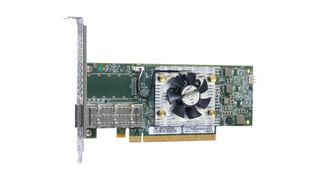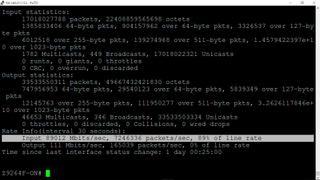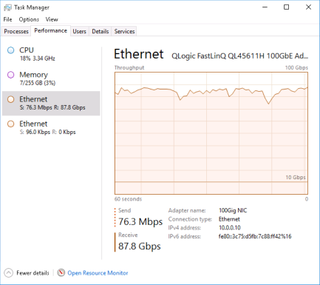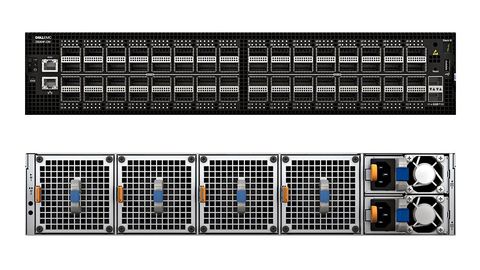IT Pro Verdict
The Z9264F-ON is perfect for fast-growing data centres as it offers a high 100GbE port density and low per-port costs while support for open networking delivers more software choices than the competition
Pros
- +
High 100GbE port density; Low cost per 100GbE port; Great performance; Open Networking support; OS10 EE includes all switching and routing features as standard
Cons
- -
Prices for 100GbE optics still high
The move from 40GbE to 100GbE in the data centre is gathering momentum and going mainstream, with port shipments expected to triple over the next year. Dell EMC is a main player in this market and in this exclusive review, we look at its new Z9264F-ON core switch which aims to offer enterprises, data centres and Tier1/2 cloud service providers a high-density 100GbE solution with a low cost per port.
Powered by Broadcom's StrataXGS Tomahawk II ASIC, the Z9264F-ON squeezes an impressive 64 100GbE QSFP28 ports into its low-profile 2U chassis. With a backplane capacity of 12.8Tb/sec, it delivers a doubling in performance and port density over Dell EMC's Z9100-ON, which was launched in 2016.
As the Z9264F-ON is a multi-rate switch, the ports can be used at their maximum speed and Dell EMC also offers a big choice of break-out cables. These allow the switch to support up to 128 10/25/50GbE links and there's also a range of QSFP+ transceivers available for converting selected ports to 40GbE speeds.
Dell EMC Networking Z9264F-ON review: Open networking
The 'ON' in its model name means this switch is a fully paid-up member of Dell EMC's open networking club. Along with Dell EMC's OS10 software, the switch can run a range of other OSes including Cumulus Linux and Big Switch Networks with support for Pluribus Networks coming soon.

Cumulus Linux is built from the ground up as a data centre-grade networking OS and can run virtually any Linux application you want. For zero-touch provisioning, Cumulus can work with the Ansible automation tool and its scripts and templates, or many other tools including Puppet and Chef.
Alternatively, you can specify the switch with the Big Switch Networks Big Cloud Fabric. This turns the Z9264F-ON into a true software-defined network (SDN) physical layer switch managed by a separate SDN controller.
Dell EMC Networking Z9264F-ON review: OS10 Enterprise Edition
Dell EMC's own OS10 Enterprise Edition (OS10 EE) software provides all the traditional switching and routing capabilities and there are no hidden costs. It includes advanced L3 features such as BGP routing and OSPF as standard and not as expensive optional extras.
OS 10 uses traditional CLI access and so far Dell EMC has resisted the temptation to implement a web GUI. As OS10 is a standard, unmodified Linux kernel, it also allows you to run certified automation tools such as Chef, Puppet, Ansible and SaltStack.
The switch supports up to 128 link aggregation groups (LAGs) each comprising up to 16 ports for high-performance switch-to-switch links. Dell EMC's VLTs (virtual link trunks) go further as they allow two switches to be placed in a high availability domain.

In a VLT domain, both switches are active, they share the same virtual MAC address and if one goes down, the other assumes all primary functions and carries on regardless with no loss of service. The mVLT (multi-VLT) feature also allows LAGs to be used to create multiple redundant connections between logical VLT domains.
Dell EMC Networking Z9264F-ON review: Optic pricing
The Z9264F-ON undoubtedly delivers a big reduction in the cost per 100GbE port but it's a shame Dell EMC can't do the same with its 100GbE optics. The SR4 850nm optic and its 100-metre reach has a list price of 3,313, while the full LR4 optic increases the reach to 10kms but costs 15,490.
Looking back at our Z9100-ON review, we can see that the same SR4 and LR4 optics three years ago had list prices of just over 2,000 and 14,609 so they've actually increased in cost. True, you don't have to use Dell EMC's own optics - but it would seem sensible if the company had made them more competitively priced.
For direct 100GbE server-to-switch connections over short distances, it's more cost-effective to use QSFP28 DAC (direct attach copper) cables. A 5-metre DAC cable costs about 572, won't require expensive optics at each end and uses a lot less power as well.
Dell EMC Networking Z9264F-ON review: 100GbE speed
For performance testing, we used two Dell EMC PowerEdge R640 1U rack servers equipped with dual Xeon Scalable Gold 6150 CPUs, plus 256GB of DDR4. Both systems were running Windows Server 2016 and equipped with QLogic FastLinQ QL45611H 100GbE HBAs cabled directly to the Z9264F-ON test switch over 100GbE links.

To generate the high throughput required to stress the 100GbE ports, we used the jPerf Windows app on both servers with one side configured as a server and the other as a client. We configured jPerf to test network throughput from the client to the server using 800 parallel streams back to the jPerf server.
After letting it settle for 15 minutes, we could see it recording a very impressive network throughput of up to 89Gbits/sec. From the switch's OS10 CLI console, we pulled up interface statistics for both ports the servers were attached to. Whilst running jPerf, we could see the CLI registering a link utilization of around 89% for each 100GbE interface thus confirming our jPerf results.
Dell EMC Networking Z9264F-ON review: Verdict
With exponential growth forecast in the data centre switching and routing market, the Z9264F-ON puts Dell EMC in a prime position. It delivers a wealth of 100GbE ports in a compact 2U form-factor allowing businesses to break away from expensive and often underutilized chassis-based solutions.
As one of the first blue-chip vendors to introduce open networking switches, it's also uniquely positioned to offer more software choices than the competition and release businesses from vendor lock-in. Dell EMC also delivers on its promise to reduce per 100GbE port costs. When the 32-port Z9100-ON was released, its list price was a shade under 31,000, whereas the starting price for the 64-port Z9264F-ON is only around four grand more.
Verdict
The Z9264F-ON is perfect for fast-growing data centres as it offers a high 100GbE port density and low per-port costs while support for open networking delivers more software choices than the competition
Chassis: 2U rack
Ports: 64 x 100GbE QSFP28, 2 x 10GbE SFP+
Backplane: 12.8Tbps full duplex
Forwarding capacity: 2,900 Mpps
Packet buffer: 42MB
CPU memory: 16GB
Power: 2 x 1600W hot-plug PSUs
Cooling: 4 x fan standard or reverse flow modules
Software: OS10.4.2 preinstalled
Dave is an IT consultant and freelance journalist specialising in hands-on reviews of computer networking products covering all market sectors from small businesses to enterprises. Founder of Binary Testing Ltd – the UK’s premier independent network testing laboratory - Dave has over 45 years of experience in the IT industry.
Dave has produced many thousands of in-depth business networking product reviews from his lab which have been reproduced globally. Writing for ITPro and its sister title, PC Pro, he covers all areas of business IT infrastructure, including servers, storage, network security, data protection, cloud, infrastructure and services.



